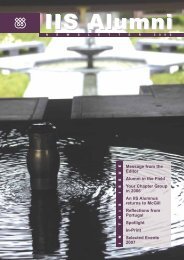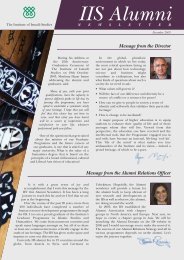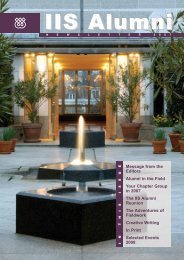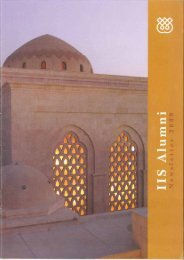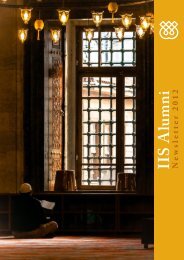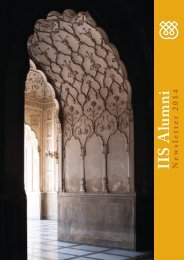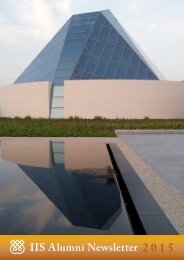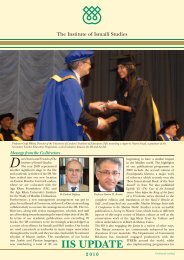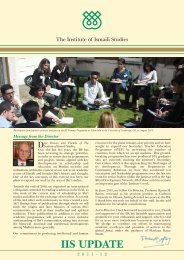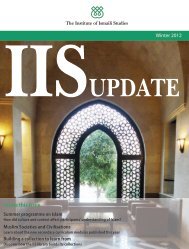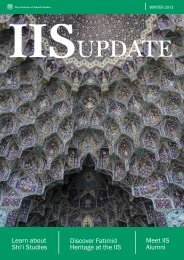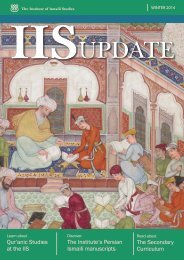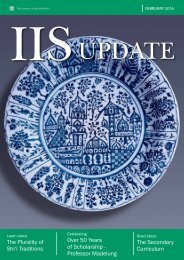IIS Alumni Booklet 2016
Create successful ePaper yourself
Turn your PDF publications into a flip-book with our unique Google optimized e-Paper software.
Muslim culture then and<br />
the Hindu culture now can<br />
be seen as dominant and<br />
affecting less influential<br />
cultures. But a more<br />
dynamic view accepts that<br />
as much as the Muslim<br />
culture affected the local<br />
Indic culture, the reverse<br />
was equally true. Akbar’s<br />
short-lived residence at<br />
Fatehpur Sikri brought<br />
together the regional<br />
architectural traditions of<br />
India which had absorbed<br />
the Indian forms earlier,<br />
and clad them in red<br />
sandstone. 9 The syncretism<br />
of different regional Indian,<br />
Central Asian and Persian<br />
styles signalled that these<br />
buildings could be attractive<br />
to all of the emperor’s subjects, regardless of their religious<br />
identity, ethnicity or geographical origin. 10 Akbar strove for<br />
a reconciliation between his Hindu and Muslim subjects,<br />
especially in intellectual and religious spheres; built his<br />
relations with the Safawids, Uzbeks and Ottomans; and also<br />
sent an envoy to the pope and King Phillip II of Spain. 11<br />
Another Mughal ruler, Aurangzeb, on the other hand,<br />
who was a strict orthodox Muslim, broke with the liberal<br />
traditions of his predecessors. The exchange of cultural<br />
elements between regional traditions and the Timurid<br />
architectural heritage the Mughal’s brought with them,<br />
along with shifts within the dynasties (as given in the<br />
example of Aurangzeb), if viewed from the new theories<br />
of cultural encounters, prevents one from seeing the shift in<br />
mere chronological fashion and thus as mere expressions of<br />
power from one dominant culture to the lesser one.<br />
More importantly, the AKTC’s work can be seen in an<br />
inclusive light, if understood from this framework of<br />
dynamic exchanges of cultural inputs. The conservation of<br />
the Baoli and Chausath Khambha are just two examples.<br />
The former is the fourteenth century stepwell which was<br />
considered holy by millions. It was desilted 80 feet below<br />
ground level for the first time in centuries and its broken<br />
parts were restored. The latter is the tomb of Mirza Aziz<br />
Koka, the cousin of Akbar, with twenty-five domed chambers<br />
supported on sixty-four marble columns. Investment in these<br />
two monuments, which may be considered of less functional<br />
value than some others but are certainly important culturally,<br />
could easily have been neglected for fear of causing a “drain<br />
on fragile economies” 12 in Basti. But restoring these sites<br />
allows or even creates a “cultural space” for further exchanges<br />
between various communities and for finding new grounds to<br />
develop the local community itself to expand its potentialities<br />
in new forms. 13<br />
After witnessing the painstaking efforts by the AKTC at<br />
Humayun’s tomb, I wondered if all the monuments we visited<br />
on our fieldtrip could be maintained equally well under a<br />
public–private partnership similar to the one between the<br />
government of India and the AKTC. Instead of the myth of<br />
the “medieval Muslim villains” taking political prominence,<br />
I walked away hoping that the story of Muslims in India will<br />
be rewritten with trust by well-meaning protagonists. This<br />
not only will enable many successful partnerships that will be<br />
of the benefit of the monuments in ruinous state but will also<br />
create more possibilities of exchange and partnership, not in<br />
favour of one or the other culture but for a seamless dialogue,<br />
called “encounter”.<br />
Reflections & Reviews<br />
1 The information within this paragraph was taken from the “Nizamuddin Urban Renewal Annual Report 2014”.<br />
http://annualreport2015.nizamuddinrenewal.org/annualreports-details/2015/136/executive-summary.php.<br />
2 Nandini Ramachandran, “Crossing Paths: Histories that Challenge the Reductionist Popular Understanding of Islam in India”, Caravan Magazine 9, no. 2 (February 2017), pp. 78–85.<br />
http://www.caravanmagazine.in/reviews-essays/islam-histories-challenge-understanding-india.<br />
3 Dominique-Sila Khan, “Being One and Many among the Others: Muslim Diversity in the Context of South Asian Pluralism”, in Diversity and Pluralism in Islam: Historical and<br />
Contemporary Discourses amongst Muslims, ed. Zulfiqar Hirji (London, I.B.Tauris, 2010), pp. 43–60.<br />
4 Ramachandran, “Crossing Paths”, p. 85.<br />
5 Richard Eaton and Phillip Wagoner, Power, Memory, Architecture: Contested Sites on the Deccan Plateau, 1300–1600 (Oxford, Oxford University Press, 2014)<br />
6 In Ramachandran, p. 83.<br />
7 See “CEPS – Cultural Encounters in Pre-Modern Societies”. http://www.en.cgs.aau.dk/research/research-groups/ceps.<br />
8 Audrey Truschke, “It is High Time We Discarded the Pernicious Myth of India’s Medieval Muslim Villains”.<br />
https://thewire.in/18919/high-time-discarded-pernicious-myth-indias-medieval-muslim-villains/.<br />
9 Ebba Koch, Mughal Architecture: An Outline of Its History and Development (1526–1858) (Delhi, Primus Books, 2014), p. 5.<br />
10 Koch, Mughal Architecture, p. 5.<br />
11 Koch, Mughal Architecture, p. 5.<br />
12 As noted in a keynote address by Mawlana Hazar Imam delivered at Hangzhou International Congress on 15 May 2013,<br />
available at: http://www.akdn.org/speech/his-highness-aga-khan/unesco-conference-china.<br />
13 https://www.bu.edu/wcp/Papers/Cult/CultGevo.htm.<br />
11



